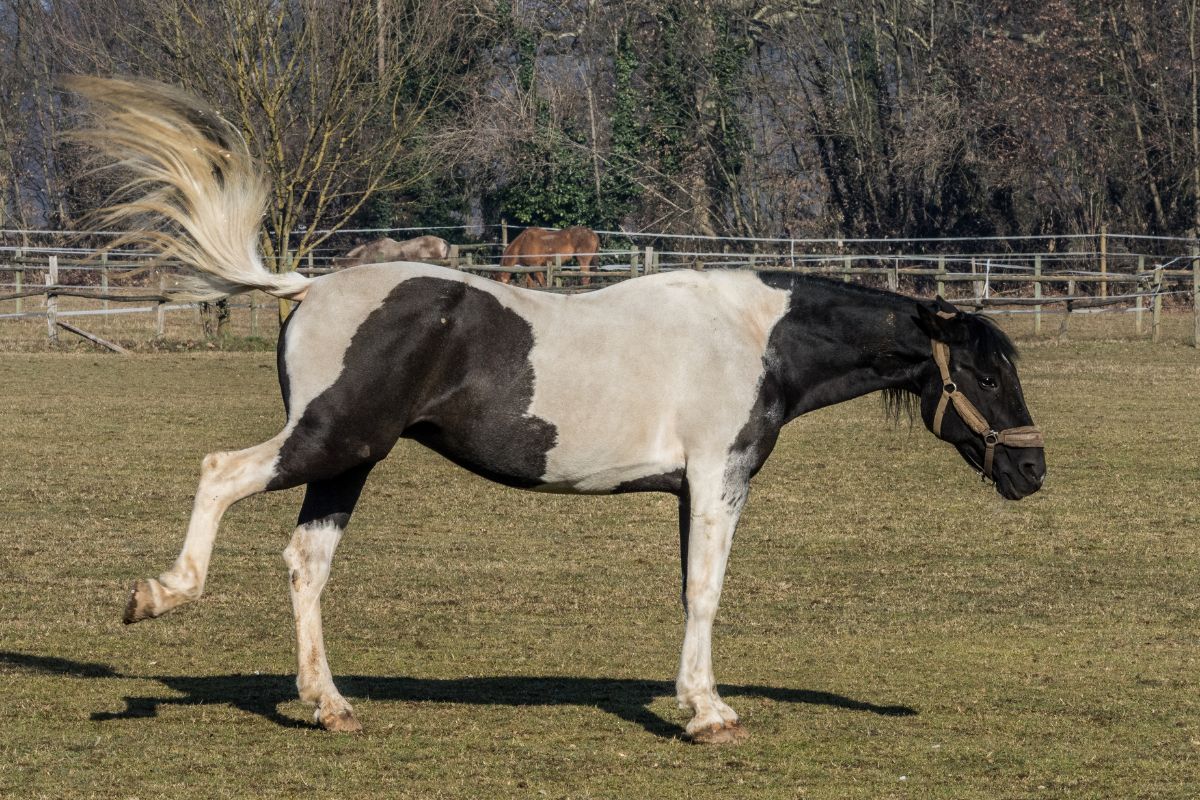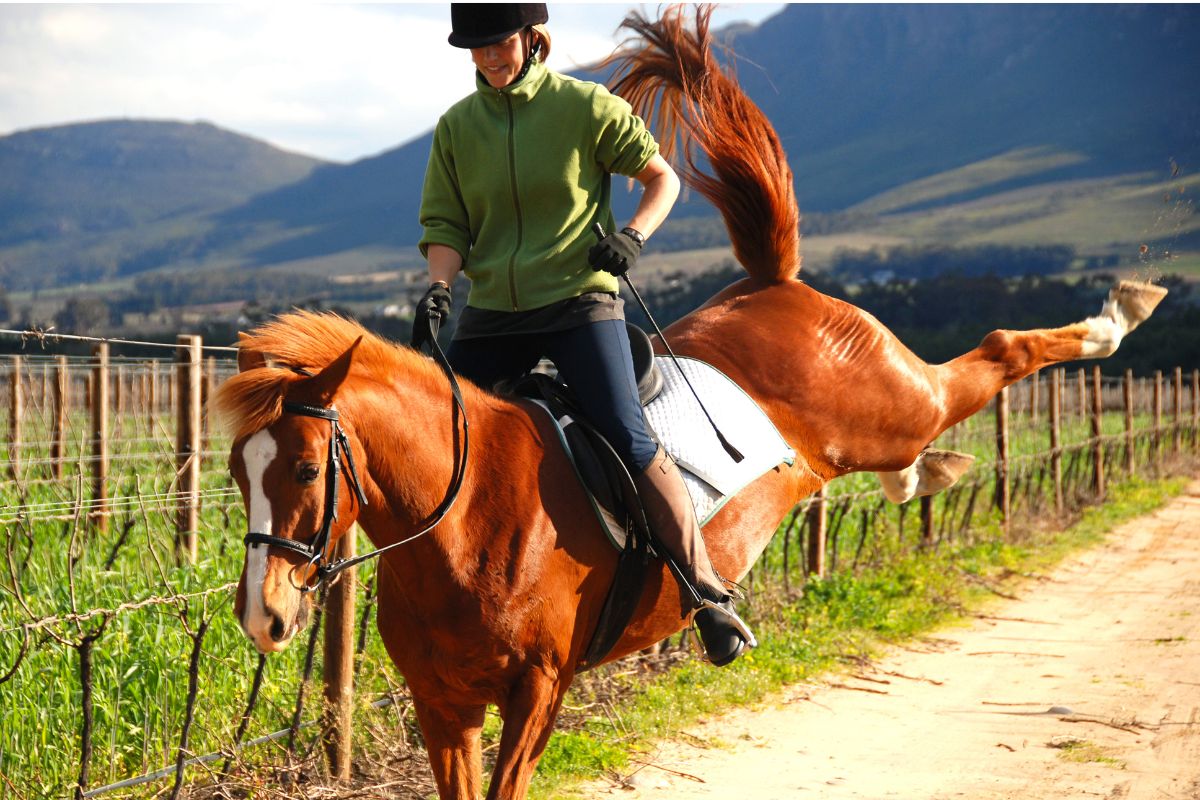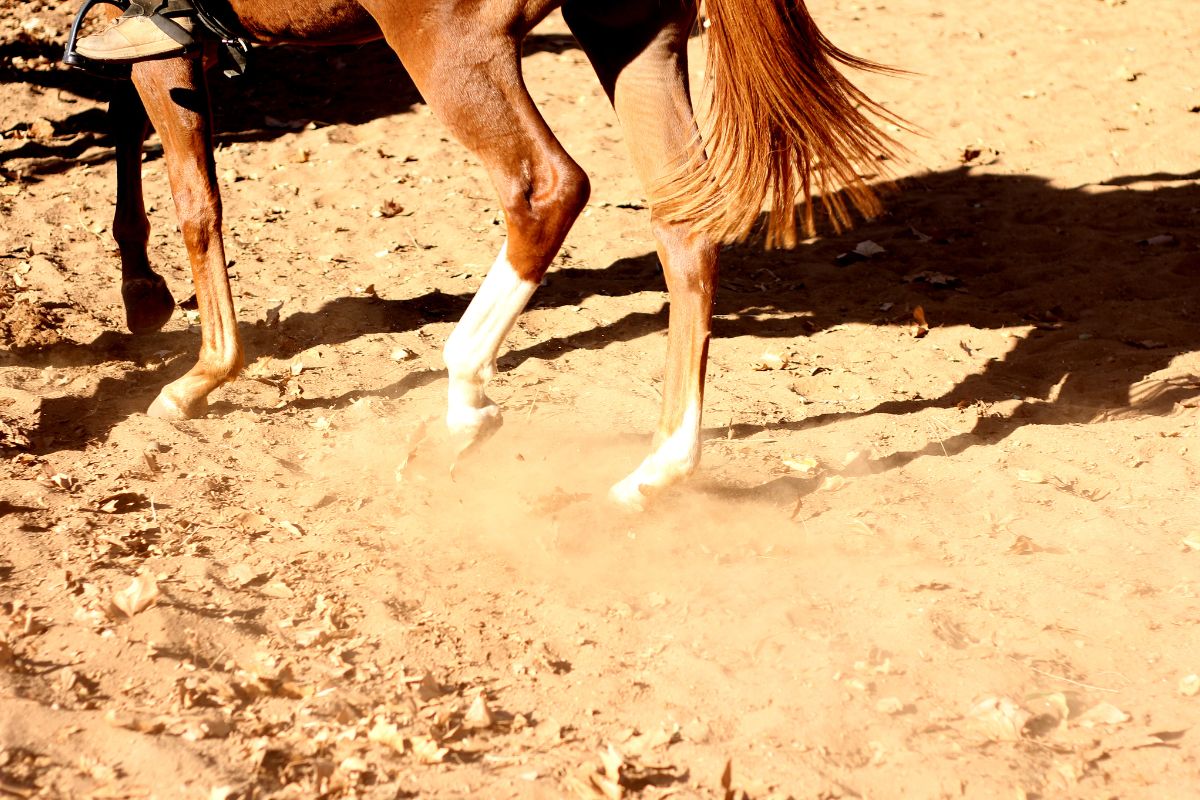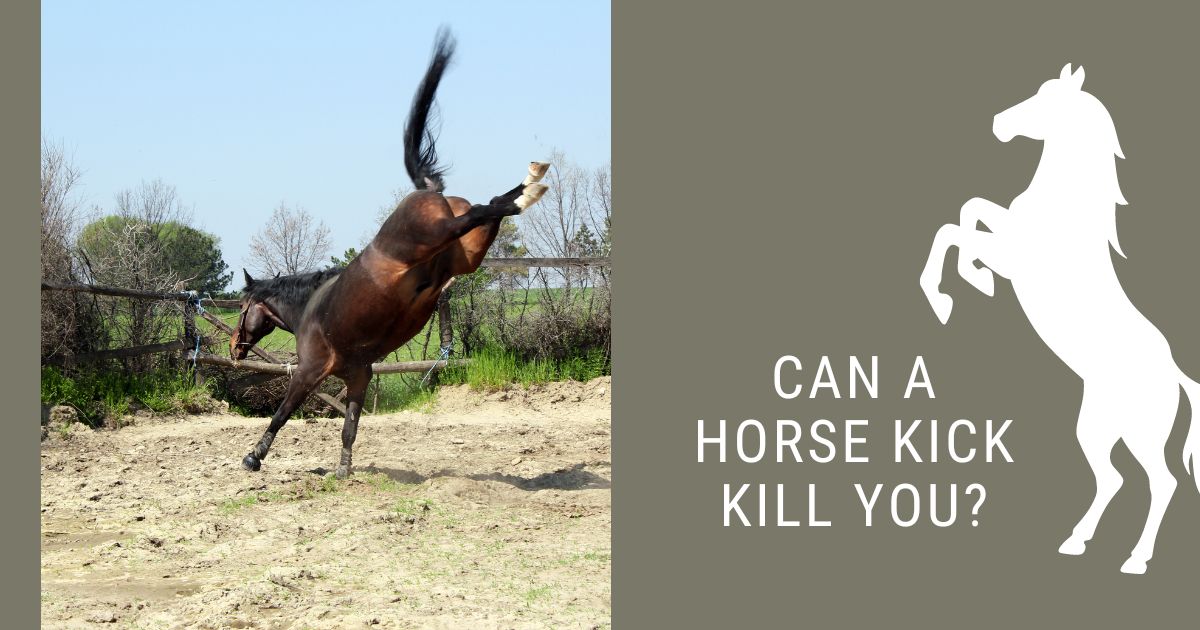Horses and Kicking
Can a horse kick kill you? Standing too close to a horse puts a person at risk of severe injury from a powerful kick, and in certain situations, it can even result in fatality within seconds.
To ensure safety around horses, it is crucial to respect their boundaries, be aware of potential triggers, and take preventive measures to avoid hazardous accidents.

Can a Kick From a Horse Kill You?
Yes, a horse’s kick can kill you if it strikes you in some regions of the body, such as the skull. The force of a horse kicking can cause anything from bruising to severe fractures or even cardiac arrest in the victim.
Horses kick as a defense against danger when frightened, annoyed, or in a foul mood. Sometimes, a kick is unpredictable; other times, you can see it coming and take corrective action.
How Strong is a Horse Kick?
The estimated horse kick force is about 2,000 pounds per square inch (907.2 kilograms per square centimeter), with an average speed of 200 miles (321.9 kilometers) per hour. To put this into perspective, the force of a horse’s kick is more than the most brutal punch any professional boxer could ever deliver.
Horse Kick Injuries to Humans
Horse kick injuries to humans can be severe and pose significant risks. Some common horse kick injuries include:
- Bruises and contusions: A horse’s kick can cause bruises and contusions, resulting in localized pain and swelling. While these injuries are generally less severe, they can still be painful.
- Fractures: The impact of a horse kick, especially with their powerful hind legs, can lead to bone fractures in the affected area. Fractures may require medical intervention, such as casting or surgery, depending on the severity.
- Soft tissue injuries: Horse kicks can cause injuries to soft tissues, including muscles, tendons, and ligaments. These injuries may result in pain, swelling, and limited mobility, requiring appropriate medical attention.
- Internal injuries: In certain instances, a forceful kick can result in internal harm, such as organ damage or internal bleeding. These injuries can be life-threatening and may necessitate immediate emergency medical attention.
- Head injuries: A kick to the head poses a significant risk, potentially causing skull fractures, concussions, or brain injuries. You should treat head injuries as emergencies, and seek prompt medical assistance.
- Infections: Open wounds from a horse kick are prone to infections. It is essential to thoroughly clean and dress any wounds to prevent infections, which could worsen the seriousness of the injury.
- Psychological impact: Beyond physical harm, horse kicks can have a psychological toll on individuals, inducing fear, anxiety, or post-traumatic stress disorder (PTSD).
Preventing horse kick injuries involves practicing proper safety measures around horses, such as maintaining a safe distance, being aware of the horse’s body language, and using appropriate equipment, such as helmets and sturdy footwear.
Additionally, proper training and handling of horses can reduce the risk of aggressive behavior. If someone experiences a horse kick injury, seeking medical attention promptly, even if the injury seems minor, is essential to ensure proper evaluation and treatment.
Why Do Horses Kick When You’re Behind Them?
Horses may kick when approached from behind due to an instinct for self-defense. In the wild, a horse’s primary means of defense against predators is to use its powerful hind legs to kick and ward off potential threats.
This instinct can still be present in domesticated horses, and various factors may trigger kicking responses:
- Startle reflex: Horses have a strong startle reflex, and approaching them suddenly from behind can startle them. In response to the surprise, a horse may kick instinctively as a defensive reaction.
- Blind spot: Horses have a blind spot directly behind them, where they cannot see what’s happening. Approaching a horse from this blind spot can make them feel vulnerable and trigger a defensive response.
- Sensitivity to touch: Some horses are more sensitive to touch than others. A sudden touch or an unexpected presence behind them can cause discomfort or fear, leading to a defensive kick.
- Discomfort and pain: If a horse is experiencing pain or discomfort in its hindquarters, it may react defensively to any approach from behind. Painful conditions, such as injuries or soreness, can make a horse more likely to kick.
- Previous negative experiences: Horses have good memories; if they have had negative experiences when approached from behind, they may develop a defensive behavior to protect themselves.
Always seek guidance from experienced handlers or trainers, especially if you are unfamiliar with a particular horse’s behavior. Understanding and respecting a horse’s instincts can contribute to a safer interaction between the horse and the handler.
Signs of a Potential Dangerous Horse
Identifying signs of a potentially dangerous horse is crucial for the safety of handlers and those around the horse. While not all horses display aggressive behavior, some may exhibit warning signs indicating they could pose a risk. Here are some signs to be aware of:
Aggressive Posture
When a horse flattens its ears against its head, it can indicate irritation, anger, or aggression. Also, a horse holding its head and neck high may display dominance or aggression.
Excessive Restlessness or Nervousness
An overly restless or constantly moving horse may be anxious or agitated, potentially leading to unpredictable behavior. Additionally, while tail swishing can signify annoyance, excessive or aggressive tail swishing may indicate a horse’s agitation or unhappiness.
Bared Teeth
Horses may bear their teeth as a display of threat, especially if accompanied by other signs of aggression.
Charging or Striking
A horse that charges forward or lunges aggressively can pose a physical threat.
Moreover, striking out with front or hind legs is a clear sign of aggression and can cause serious harm.
Unpredictable Behavior
A horse with unpredictable or inconsistent behavior may be more challenging to handle safely.
Resistance to Handling
A horse that consistently resists handling, grooming, or basic care may have behavioral issues that need addressing.
Excessive Fear or Nervousness
A horse that overreacts to stimuli with fear, such as sudden movements or loud noises, may be more prone to unpredictable behavior.
History of Aggressive Incidents
If a horse has a history of aggressive behavior or injuring handlers or others, you should approach it cautiously.
Sudden Changes in Behavior
You should evaluate a horse suddenly becoming aggressive or displaying a significant behavior change for potential underlying issues. It’s essential to note that individual horses vary, and some behavioral signs may result from fear, pain, or inadequate training.
Suppose you suspect a horse may be dangerous. In that case, consulting with an experienced equine professional, such as a trainer or veterinarian, is advisable for further assessment and guidance on handling and managing the horse safely.
Additionally, always prioritize safety and adhere to proper handling techniques when interacting with any horse, regardless of its perceived temperament.

Precautions to Take When Around Horses
Handling horses requires knowledge, respect, and caution to ensure the safety of both the handler and the horse. Here are some essential precautions to take when around horses:
Speak Softly
Use a calm and reassuring voice when around the horse. This can help keep the horse at ease and reduce the risk of startling.
Stay Alert to the Horse’s Body Language
Pay attention to the horse’s body language, including ear position, tail movement, and overall demeanor. Understanding these cues can help you anticipate the horse’s reactions.
Avoid Sudden Touch or Loud Noises
Avoid sudden touches or loud noises, as these can startle a horse. Make your presence known and give the horse time to acknowledge you.
Maintain a Safe Distance
Keep a safe distance from the horse, especially around its hindquarters. Horses may kick if threatened, so be cautious when working nearby.
Wear Appropriate Gear
Wear appropriate gear, including sturdy footwear, gloves, and, when necessary, a helmet. This can protect in case of accidental kicks or other incidents.
Approach With an Open Hand
When offering treats or petting, approach the horse with an open hand, allowing it to see and sniff before making contact.
Be Mindful of the Horse’s Blind Spots
Horses have blind spots directly in front of and behind them. Be aware of these areas and move gradually when nearby.
Avoid Fast Movements
Avoid fast movements or sudden gestures, as they can startle the horse. Move slowly and deliberately.
Secure Fencing and Enclosures
Ensure that fencing and enclosures are secure to prevent the horse from escaping or injuring itself.
Supervise Interactions With Children
Supervise interactions between horses and children closely. Teach children to approach horses with caution and to follow safety guidelines.
Seek Professional Guidance
If you are unfamiliar with handling horses or encounter challenging behavior, seek guidance from experienced handlers, trainers, or veterinarians.
How to Stop a Horse From Kicking
Stopping a horse from kicking requires understanding the horse’s behavior, proper training techniques, and consistent positive reinforcement. It’s essential to approach this process with patience, respect, and a focus on building trust. Here are some steps to help stop a horse from kicking:
Identify Triggers
Observe the horse to identify specific triggers that lead to kicking. This could include certain situations, people, or activities that make the horse feel threatened or uncomfortable.
Positive Reinforcement
You can reinforce positive behavior with rewards, such as treats or praise when the horse behaves calmly and does not exhibit kicking behavior.
Desensitization
Gradually desensitize the horse to potential triggers. Introduce the horse to situations or objects that may have caused kicking in the past in a controlled and non-threatening manner.
Training With Distraction
Train the horse to focus on commands or tasks to distract it from potential triggers. This can help redirect its attention and prevent kicking.
Professional Training
If the horse’s kicking behavior is persistent or dangerous, consider seeking help from a professional horse trainer. They can assess the specific situation and provide targeted training techniques.
Correct Undesirable Behavior Promptly
If the horse exhibits kicking behavior, correct it promptly but calmly. This might involve a verbal command or redirection. Avoid aggressive or punitive measures, as they can escalate the situation.
Establish Trust
Building trust with the horse is crucial. Spend time bonding with the horse through grooming, groundwork, and positive interactions to establish a trusting relationship.
Regular Handling and Interaction
Consistent, regular handling and interaction with the horse can help you reinforce its positive behavior and build a stronger bond between you and the horse.
Vet Check
Ensure the horse is not in pain or discomfort, as underlying health issues can contribute to undesirable behaviors. You can consider consulting a veterinarian if you suspect any health concerns.
Remember that each horse is an individual, and you may need to tailor the approach to stopping kicking to its specific personality and experiences.
Can Horses Get Mad at Humans?
Horses can recognize human emotions and differentiate between anger and happiness through facial expressions. They can also read humans through body odors, posture, facial expressions, and attentiveness.
However, there is a gap in the literature on whether horses can empathize with human emotion.
Respecting horses’ boundaries and recognizing potential triggers to prevent dangerous accidents is essential. While horses may not necessarily get “mad” at humans, they can react negatively if they feel threatened or uncomfortable.
Signs That a Horse is About to Kick
Horses may exhibit several warning signs before kicking, allowing individuals to recognize and avoid potentially dangerous situations. Some common signs that a horse is about to kick include:
- Pinned ears: When your horse pins its ears flat back against its head, it may indicate anger or unhappiness, indicating that the horse may be about to behave aggressively, including kicking.
- Tail swishing: Horses getting upset may twitch or swish their tails back and forth. If combined with other warning behaviors like pinned ears, tail swishing may indicate that the horse is working itself up to kicking.
- Lifting or cocking one hind leg: If a horse lifts or cocks one hind leg and is not bearing any weight on it, it may be preparing to kick.
Our Horse Kick First Aid Tips
Being kicked by a horse can result in various injuries, and prompt first aid is crucial to minimize complications and promote healing. Here are some general first-aid tips if a horse kicks someone:
Assess the Situation
Ensure the area is safe for the injured person and the horse. Remove any immediate threats and make sure the horse is under control.
Seek Professional Medical Help
If the injury is severe, involves significant bleeding, or if there are signs of internal injuries, call for professional medical help immediately. Don’t delay seeking emergency assistance.
Control Bleeding
If there is bleeding, use a clean cloth to apply pressure to the wound. If feasible and without causing extra pain, elevate the injured limb.
Clean the Wound
Once you control bleeding, clean the wound with mild soap and water. Avoid using substances that can further irritate the injury.
Apply Antiseptic
Apply an antiseptic ointment or solution to help prevent infection. You can use a sterile dressing to cover the wound.
Bandage the Wound
Use sterile bandages or dressings to cover the wound and secure them in place. Make sure the bandage is not too tight to allow for proper circulation.
Immobilize the Injured Area
If there is a possibility of fractures or dislocations, try immobilizing the injured area without causing additional pain. Use splints or supportive bandages as needed.
Pain Management
If the injured person is in pain, provide pain relief following appropriate guidelines. You may use over-the-counter pain medications, but consult a healthcare professional for specific recommendations.
Monitor for Signs of Shock
Horse kicks can be traumatic, and the injured person may go into shock. Watch for signs of shock. These may include pale skin, rapid breathing, or confusion. Keep the person warm and seek medical attention.
Document the Incident
Write down the circumstances surrounding the injury, the location, and any details that might be relevant for medical professionals. This information can help provide proper care.
Follow Up with Medical Care
Even if you administer the initial first aid, following up with professional medical care is important. Injuries from horse kicks can sometimes have delayed complications.
Remember, these first-aid tips are general guidelines. The severity of an injury will determine the appropriate response. Always prioritize the safety of both the injured person and those providing assistance. If in doubt, seek immediate professional medical help.

The Word’s Out!
In conclusion, while most horse interactions are enjoyable and safe, it is essential to recognize the potential dangers associated with horses kicking people. Horses are powerful animals, and their kicks can cause serious injuries, ranging from fractures to internal damage.
Understanding horse behavior, practicing proper safety measures, and being aware of potential risk factors can significantly reduce the likelihood of people getting kicked by horses. Always approach horses cautiously, follow recommended safety guidelines, and seek professional guidance when needed.
By prioritizing safety and respecting these magnificent animals’ innate nature, horse enthusiasts and casual handlers can foster positive relationships with these creatures while minimizing the risks associated with their powerful kicks.
